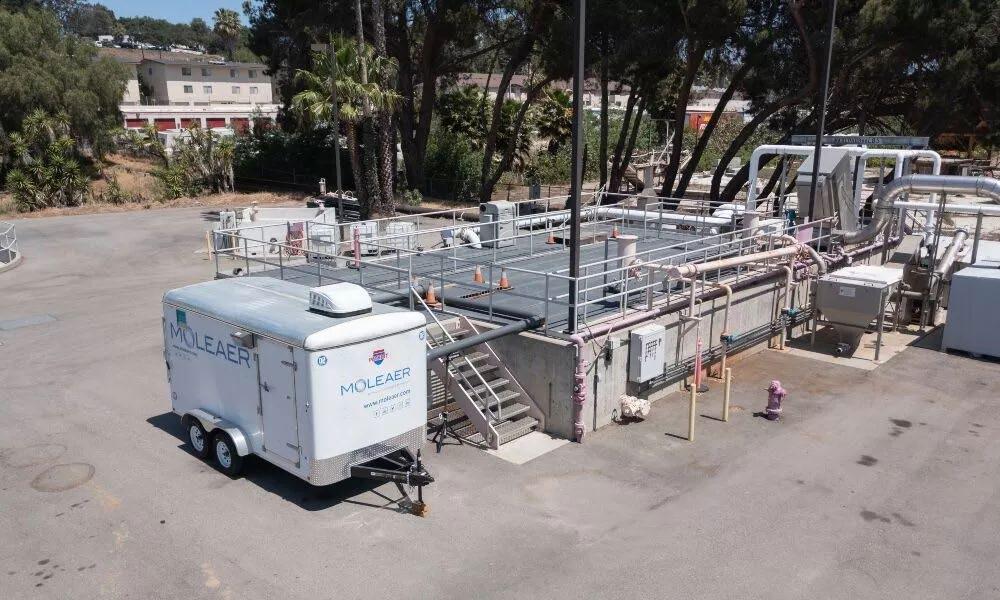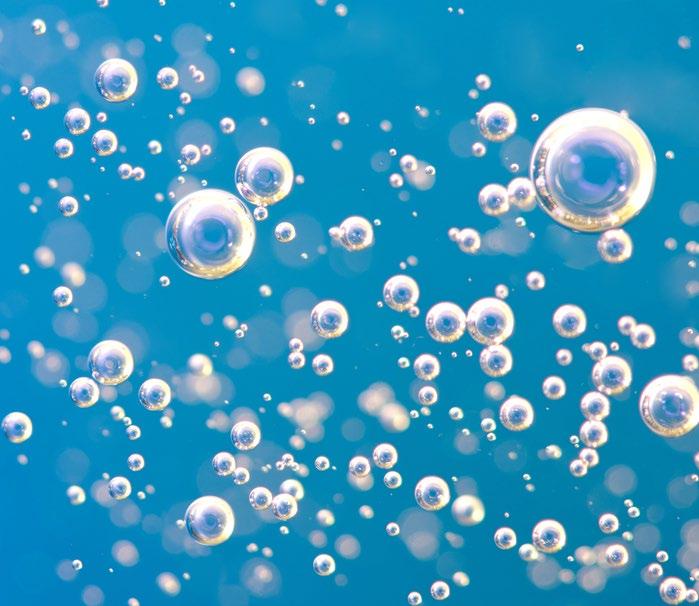
10 minute read
Improving Access to Water Quality Testing - SimpleLab Chief Science Officer, Dr Jess Goddard
Moleaer: Tiny bubble tech makes a big splash
Exclusive interview: H2O Global News editor Siôn Geschwindt caught up with Nick Dyner, CEO of Moleaer, to find about more about nanobubble technology, its myriad benefits, and how it can help the water industry on its journey to net zero.
Advertisement

quality, water treatment, and efficiency benefits for a number of different industries,” said Nick Dyner, CEO of Moleaer, to H2O Global News.
Based in California and founded in 2017, Moleaer was born after its co-founder Bruce Scholten discovered a new method to produce billions of nanobubbles at an industrial scale.
The first company to bring nanobubble technology to market, Moleaer creates nanobubbles and uses machines to diffuse them into water supplies, sustaining the level of dissolved oxygen.
Dyner says the solution is far more effective than typical aeration technologies which generally achieve less than 3% oxygen transfer efficiency. This means that only a small fraction of the injected gas dissolves in the water – the rest bubbles up to the surface and is released back into the atmosphere.
However, Moleaer claims its proprietary technology is 30 times more efficient, enabling dissolved oxygen (DO) levels to increase while using far less oxygen.
This helps various sectors like agriculture and the water industry to reduce their water, chemical, and energy footprint, Dyner says.
Doing more, with less
Aeration alone makes up an estimated 70-80% of all energy consumed at a standard Wastewater Treatment Plant (WWTP).
This is because WWTPs clean water and remove contaminants primarily by circulating air to
The quantity of dissolved oxygen (DO) in water directly impacts its quality and its ability to support life. Just compare a fresh mountain stream to an algae-infested pond and the importance of DO becomes clear.
This is why a whole industry exists to provide aeration products and services – to keep water oxygen levels at or above a certain threshold.
But there is a new technology on the scene disrupting the norm and promising a host of other benefits too: nanobubbles.
Small is beautiful
Nanobubbles are tiny bubbles between 70-120 nanometers in size – 2500 times smaller than a single grain of salt.
Due to their microscopic size, they possess distinct properties from regular bubbles. They aren’t buoyant, they have a strong negative surface charge, and they release hydroxyl radical (HO) when they destabilise – a naturally-occuring oxidiser commonly used to destroy contaminants. encourage the growth of beneficial bacteria.
The problem is that in the UK, for instance, WWTPs only source about 8.5% of their electricity from renewables.
Many water companies have committed to delivering a net zero water supply to customers by 2030. But in order to achieve this ambitious target they will need to come up with innovative ways to boost the efficiency of their processes.
The Fallbrook WWTP, California, was one such facility that faced challenges associated with inefficient aeration performance, largely due to the detrimental impacts of surfactants.
Surfactants reduce the surface tension of water and deplete oxygen levels – making typical aeration processes less effective. Typically 40-60% of the energy required to dissolve oxygen into wastewater can be attributed to the negative impacts of surfactants alone.
To tackle the issue, Fallbrook called in Moleaer. The company conducted two 25-day pilot studies using one of its nanobubble generators.
The nanobubbles were injected into a headworks basin upstream of the primary clarifiers to treat an average daily influent flow of 1.4 million gallons per day. Data on water quality and operating parameters, including dissolved oxygen (DO) and oxygen transfer efficiency, were measured throughout the pilot studies.
Nanobubble technology will become 'standard kit' across many industries in the futureMoleaer’s nanobubble generator at Fallbrook Wastewater Treatment Plant
Third-party verified results showed that Moleaer’s nanobubble technology was able to reduce the organic and surfactant loads, resulting in an aeration energy savings that averaged 30% of the plant’s historical annual aeration expenditures. 60% more oxygen was transferred and 45% potential energy savings were made.
“The data collected showed how the adoption of the Moleaer nanobubble technology nearly doubled the energy efficiency of our existing fine-bubble aeration system, due to the ability of nanobubbles to remove surfactants from the influent wastewater,” said a Fallbrook WWTP representative.
These results are not isolated. Hundreds of use cases and several peer-reviewed studies show that nanobubbles can replace or improve the efficiency of water aeration processes.
They also have a big role to play in agriculture, another industry that uses aeration technology extensively and also consumes a huge amount of water – 70% of the world’s total in fact.
“Nanobubbles cut costs for farmers, but they also oxygenate the water which brings higher crop yields and builds resilience in the root zone,” said Dryner. “This is proven to lower the water demand of plants – helping to reduce the water intake of agriculture.”
The benefits of nanobubbles are hard to deny, and clearly investors agree.
In May, Moleaer raised $40 million in a Series C funding round led by cleantech investors Apollo, bringing the company’s total funding raised to $61 million.
The company plans to use the fresh funding to ramp up every aspect of their business – from expanding their R&D lab to growing their international presence.
Dyner believes that nanobubble technology will become ‘standard kit’ across many industries in the future, driven by the demand for more efficient and sustainable solutions.
“If we are to mitigate and adapt to climate change, we need to start thinking about how to manage our water more effectively,” he added. “Nanobubbles just make sense – they are low risk and have so many benefits, and for this reason will no doubt be the go-to aeration technology of the future.”
Moleaer’s nanobubble generator at Fallbrook Wastewater Treatment Plant

Erica Brown
Chief Strategy and Sustainability Officer Association of Metropolitan Water Agencies
Jessica Evans

The Association of Metropolitan Water Agencies (AMWA) is an organisation of the largest publicly owned drinking water systems in the United States. AMWA's membership serves more than 160 million people – from Alaska to Puerto Rico – with safe drinking water.
Climate change is water change. Do you agree? Absolutely. Scientific research has found that climate change is impacting the hydrological cycle and threatens drinking water supplies in the United States in a number of ways, including increased evaporation reducing water storage volume, rising sea levels bringing saltwater intrusion to inland water supplies, changes in seasonal rainfall patterns, reduced mountain snowpack, and increased water contamination as a result of heavier storm intensity and increased turbidity and sedimentation.
How do you think climate change will impact your membership organisations? Climate change already affects the business of AMWA members and will continue to do so. As a result, adaptation to these changes will continue to require investment in operational, technological, and infrastructure upgrades and development.
AMWA led the charge for one of the first cost assessments of climate change adaptation on drinking water and wastewater utilities back in 2009. The report estimated the costs of adaptations to address the likely impacts of climate change on our nation’s drinking water and wastewater utilities through 2050 and found the costs to utilities could range from $448 billion to $944 billion based on climate projects available at the time.
Do you think your members are adequately considering climate change adaptation in their business strategies? Many AMWA utilities are leaders in the field of climate change adaptation and take the opportunity to collaborate with other utilities to share how to incorporate climate change in their long-term operations and planning.
The Water Utility Climate Alliance (WUCA) is an alliance of twelve water utilities that are all AMWA members across the United States. WUCA provides leadership and collaboration to advance climate change adaptation, planning, and decision-making at water utilities. In 2021 WUCA led the sector by releasing a report on leading climate adaptation practices and case studies.
WUCA and AMWA have long partnered to develop and share best practices with the water sector, including initiatives like assessing and mitigating heat impacts on the water workforce and water infrastructure.
AMWA member organisations have led efforts to make the business case for adaptation. From finding cobenefits and low-regret adaptation strategies, AMWA members from coast to coast are demonstrating how adaptation strategies across core business areas including financial planning make for a more resilient water supply and community. What role should the government play in promoting climate adaptation tech? Government should prioritise making its climate and forecasting science available and actionable for businesses and other decision makers.
Furthermore, America’s water infrastructure needs billions of dollars’ worth of improvements in the coming decades, not accounting for the additional stresses that climate change imposes. Increased government investment in this infrastructure and the development of alternative water supplies will help utilities adapt to these serious challenges.
Likewise, the federal government should offer incentives for carbon-emitting operations, including water utilities, to take proactive steps to reduce their emissions and increase the efficiency of both their plants and customers’ water usage.
What promising policy changes have we seen so far in the US? The US federal government has recently taken some promising steps. For example, the Bipartisan Infrastructure Law authorised $250 million over five years for the Midsize and Large Drinking Water System Infrastructure Resilience and Sustainability Program that will offer new EPA grants to help drinking water systems counter threats associated with climate change and extreme weather.
AMWA is urging Congress to begin appropriating those funds now. Additionally, the Inflation Reduction Act provides $25 million to support projects in the American west to cover water conveyance facilities with solar panels to generate renewable energy or similar solar projects that increase water efficiency.
That law also carries $4 billion to support certain drought mitigation activities in states where water supply is overseen by the Bureau of Reclamation. Eligible activities include voluntary reductions in water consumption and system conservation projects that reduce water demand in the Upper or Lower Basins of the Colorado River.
If you could make one type of water innovation mainstream overnight, which would it be? Water smart and efficient technologies, such as those labelled by Water Sense, a program of the US Environmental Protection Agency. Ubiquitous uptake of water efficient technologies is low hanging fruit that will move us toward a more sustainable use of water and energy. What does a ‘water positive’ future look like to you? A water positive future would ensure water security, resilience, and sustainability, and that all water users do their part to minimise their impacts on water supplies and quality.
In this future, technological innovations that allow for water supply flexibility by local water utilities and other water users would be available, affordable, and supported by the most stringent environmental and public health research.
A water positive future requires innovative approaches to the use of limited water resources and may include the use of technologies like direct and indirect potable water reuse or non-potable water recycling, which have the potential to augment traditional water supplies.
Approaches to potable water reuse may involve diverting a portion of return flows either into an existing supply reservoir or directly into a water treatment facility. Water utilities must be diligent while implementing these new technologies to ensure continued protection of public health. This new supply may serve both human consumption and emergency response purposes. Similarly, in a water positive future, recycling of non-potable water used by manufacturing and other businesses would meet environmental and ecological sustainability goals.
In the past twenty years, the majority of large urban drinking water utilities have reduced their production due to a reduction in water use even though populations have increased. In addition to low-flow toilets, showerheads, and more efficient home and industrial appliances that reduce both water and energy use, the mainstream use of soil moisturesensor and weather-based irrigation controllers would also help homeowners and others reduce their water use.
If water efficient technologies were employed wherever possible in every household, hundreds of billions of dollars in water and energy costs would be saved, resulting in more sustainable water use and a reduction in greenhouse gases.










